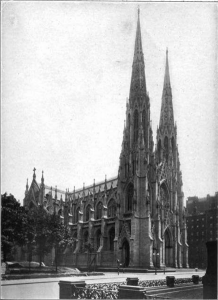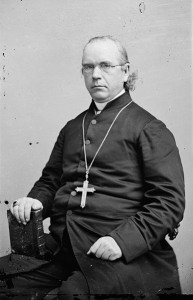Even with all the tension between the North and South, especially focused on Fort Sumter and Charleston, there are still genial interactions between the sections – at least intended interactions.
From The New-York Times March 18, 1861 (The New York Times Archive):
ST. PATRICK’S DAY.; The Celebration Yesterday Solemn High Mass at St. Patrick’s Cathedral Programme of the Demonstrations To-Day.
“Sprigs of shillelah and shamrocks so green” were rampant, yesterday, on the recurrence of the birthday of that honored Saint, St. Patrick, who, though said to have been born on the 8th or 9th of Marth, has the homage this year of natal celebration on the 17th and 18th — for it must ho remembered the secular festivities of the occasion are to be continued to-day — possibly reaching into tomorrow morning. So far as the devotional character of the ceremonies yesterday would permit, the devotees of St. Patrick enjoyed the day. But they generally reserved until this evening the more delightful recreation and observance of “drowning the shamrock” — which the “Friendly Sons” are in the habit of doing to their hearts’ content.
SERVICES AT ST. PATRICK’S CATHEDRAL.
The vast edifice in Mott-street was crowded in every part yesterday morning, in view of the announcement that High Mass would be said, and that Bishop LYNCH, of Charleston, would preach the Panegyric of St. Patrick. Even the aisles were crowded to excess, and more than one lady was obliged to retire with symptoms of fainting and exhaustion. …
It was at first contemplated to deliver the sermon before the Mass had concluded, but owing to the unaccountable non-arrival of Bishop LYNCH, the Vicar-General was obliged to announce, while the collection was being taken, that the sermon would be preached at the end of the Mass. It seems that Bishop LYNCH took passage in the steamer James Adger, and expected to reach this City last Friday. It was hoped that he might arrive before the end of the Mass, but he did not come, …
THE MILITARY AND CIVIC PARADE TO-DAY.
Besides the various annual dinners, of which the 77th anniversary of the “Friendly Sons of St. Patrick” takes the lead, there will be a military and civic parade, of which the following programme has been issued by Lieut. Col. NUGENT, of the 69th, and Grand Marshal KEENAN:
The military, under command of Lieut. Col. NUGENT, will form in Grand-street in the following order: …
The column will march down East Broadway and Chatham street, passing in front the City Hall, will be reviewed by the Honorable the Mayor and Common Council, passing out through the west gate of the Park, will proceed up Broadway to Twenty-third-street, through Twenty-third-street to First-avenue, down First-avenue to Eighth-street, up Eighth-street to the Cooper Institute and dismiss.
CLEAN STREETS ON THE LINE OF THE PROCESSION.
The new contractor for cleaning the streets has promised to clean the path chosen for the cavalcade of Erin’s sons, either by removing the dirt altogether, or by sweeping it aside so as to afford a comparatively safe gauntlet through the centre of the street. Regarded even in this light, St. Patrick’s Day will prove a public blessing — if it don’t rain!
Obviously, in those days street cleaning involved a lot more than getting some light dirt off the sides of asphalt.
Bishop Patrick Neeson Lynch did have a role in the CSA. (from Wikipedia):
On February 20, 1864 he was named by President Jefferson Davis of the Confederate States of America to be its delegate to the Holy See which maintained diplomatic relations in the name of the Papal States. Pope Pius IX, as had his predecessors, condemned chattel slavery. Despite Bishop Lynch’s mission, and an earlier mission by A. Dudley Mann, the Vatican never recognized the Confederacy, and the Pope received Bishop Lynch only his ecclesiastical capacity.
Robert Nugent was in charge of the 69th New York State militia as it organized the parade, probably because Michael Corcoran was on trial
USS James Adger (from Wikipedia):
was a United States Mail Steamship operating between Charleston, South Carolina and New York City, New York. Owned by James Adger II (James Adger & Co) of Charleston, she was seized while in New York City at the outset of the Civil War and converted for military duty by the Union Navy.



